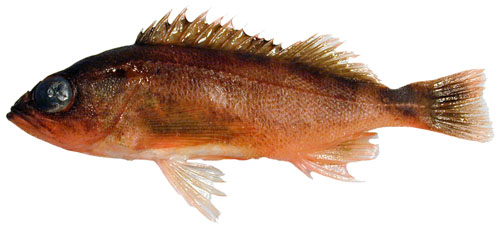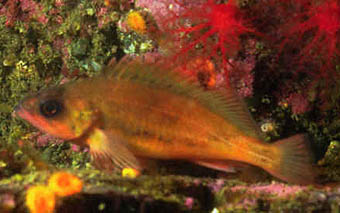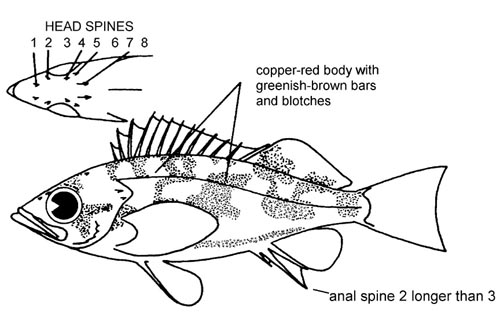|

The Puget Sound rockfish (Sebastes emphaeus)
grows to 7.2 in. (18.3 cm), making it one of the smallest rockfishes.
Its coloration is pink-red, orange-brown, or brown when seen underwater.
Beneath the lateral line a dusky to dark brown stripe is usually present
along the flanks. Green spotting appears above the line. Out of water
the stripe and all coloration fades. DNA studies show that this species
may be most closely related to the pygmy and
harlequin rockfishes. The Latin name
emphaeus means "display."
Abundance information for the Puget Sound rockfish is relatively unknown, though
they have been commonly found from southeast Alaska to Oregon. Their
known range extends from Prince William Sound in the Gulf of Alaska to
northern California. Adults are found in depths between 10 ft. and 1,200
ft. (3-366 m). In Alaska, this rockfish lives in shallower depths during the
summer, moving to deeper waters during winter. In Puget Sound, the newly
spawned one-inch long juveniles are first seen in January and February
often living at the bases of rock walls in nearshore waters. In Puget
Sound and Alaska waters, they are often the most common fish living
around the inshore rocks. During winters In Puget Sound, individuals may
be found inhabiting caves.
 |
|
Puget Sound rockfish are solitary and may also aggregate with others, sometimes in
schools of thousands. Schooling occurs primarily during daylight hours
in the water column. Their midwater diet consists of lingcod eggs (Puget
Sound) and small zooplankton, such as copepods, invertebrate larvae,
arrowworms, and gelatinous creatures, among others. Lingcod and rock
outcrop dwelling rockfishes feed on Puget Sound rockfish.
About 3,300 and 58,000 eggs are produced each year, depending on the
size of the female Pugets. A gestation period of about one month occurs
after fertilization. Females often position themselves in crevices to
release larvae. Larval release in southeast Alaska occurs from June to
August, peaking in July, and occurs later, August to September, in Puget
Sound. Females mature as young as one year of age. After maturity,
females are usually larger than males at any given age. Males
reach maximum length at an earlier age. Pugets can live to 22 years or
more.
Puget Sound Rockfish are insignificant to both the commercial and recreational
fisheries. They are rarely taken due to their small size.
Adapted from Love, M. 2002 Sebastes emphaeus, p. 168-169. In M. S. Love,
M. Yoklavich, and L. Thorsteinson, The rockfishes of the northeast Pacific. Univ. California Press.

AFSC
Rockfish Guide
|

